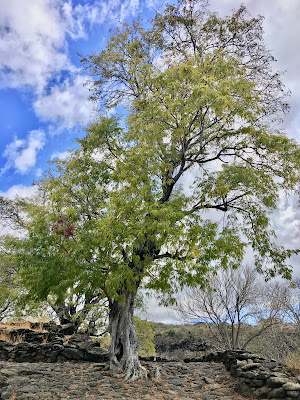Chemin Pavé Bellemène is one of three paved pathways that Antoine Desforges-Boucher*, then Governor of Reunion Island, had built between 1723 and December 1725. He encouraged settlers to plant coffee, and the paths were to help transport the crop downhill to the large warehouse in Saint-Paul (which is now the Town Hall). The first path was laid in 1719, and the Bellemène path was the last of the three to be built. Today it is the only one remaining, as increasing use of asphalt roads from 1910 onwards led to all three paths falling into disuse and being forgotten. Albert Lougnon 'rediscovered' it in the late 20th century (hence its alternative name, Chemin Lougnon), and this led to its renovation by local associations between 1999 and 2006. In certain places it was covered by two metres of earth!
 |
| start of the paved path, Tour des Roches |
On some sections of the path you can clearly see a line of differently-sized and -placed stones running along the middle. This may have been to make it easier for pedestrians (as opposed to ox-drawn carts) to walk, or it may have been to delimit two different directions of traffic (a bit like today's two-lane roads).
 |
| note the stones running along the middle |
 |
being watched by a zebu
|
Leconte de Lisle, a French poet who grew up on Reunion Island, wrote a poem in which he mentions his muse and cousin, Marie-Elixène de Lanux, coming down the path:
"Sous un nuage frais de claire mousseline, tous les dimanches au matin, tu venais à la ville en manchy de rotin, par les rampes de la colline." (Le Manchy, Poèmes Barbares)
"Under a cool cloud of clear muslin, every Sunday morning you came down the winding hill into town, carried in a rattan litter."
 |
the branches of these two trees have become intertwined
|
 |
a Pithecellobium dulce tree, also known as
monkeypod due to its coiled pods
which are said to resemble monkey's earrings!
|
 |
view looking north-west, unidentified tree in the foreground
|
 |
cactus
|
 |
| view looking south-west, agave stem in the foreground |
 |
photo from the Bellemène end of the path, looking back
|
From a practical point of view, you can either start the walk at Tour Des Roches and go uphill (and then back down), or start in Bellemène and walk down and then up. The path is quite steep (just under 200m of elevation gain) but the round-trip distance is 2.5 to 3 km, so it should only take you about an hour. The following links describe the walk and give more technical details but are only in French:
 |
on a house near the start of the path in Tour des Roches a
sign says: "Hey, papaya thieves, next time you will die!" |
* not to be confused with his son, Antoine Marie Desforges-Boucher, who was also a Governor of Reunion 1759-1766.
See also:































